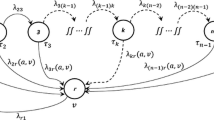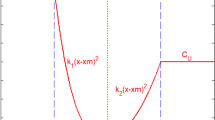Abstract
In this study, an economic production quantity (EPQ) model is generalized by considering maintenance and production programs for an imperfect process involving a deteriorating production system with increasing hazard rate. There are two types of preventive maintenance (PM), namely imperfect PM and perfect PM. The probability that perfect PM is performed depends on the number of imperfect maintenance operations performed since the last renewal cycle. Following a failure, the delayed repair performs some restorations and reduces production rate to restore the system into an operating state (in-control state), but leaves its lower production rate until perfect PM is performed. That is, the production run period not always starts in normal production rate. This study considers backorders, as well as loss of inventory due to the lower production rate. For the EPQ model, the optimum run time, which minimizes the total cost, is discussed. Various special cases are considered, including the maintenance learning effect. Finally, a numerical example is presented to illustrate the effects of PM ability, repair cost and production decreasing rate on total costs and production period.
Similar content being viewed by others
Abbreviations
- T :
-
Time of each production run
- T 1 :
-
Period of production stoppage and inventory depletion; \({T_1 =(\frac{p}{d}-1)T}\)
- *:
-
Implies an optimum value
- p :
-
Normal production rate in units per year
- Q :
-
Production lot
- d :
-
Demand rate in units per year; p > d
- α :
-
Production decreasing rate after delayed repair
- \({\bar{{P}}_j }\) :
-
Probability that the first j PM are imperfect PM; \({\bar{{P}}_0 =1}\)
- p j :
-
Probability that PM is perfect following the (j − 1) imperfect PM; \({p_j =\bar{{P}}_{j-1} -\bar{{P}}_j }\)
- \({\{\bar{{P}}_j \}}\) :
-
Sequence of \({\bar{{P}}_j ,j=0,1,2, \ldots }\)
- q j :
-
Probability that the j-th PM is an imperfect PM; \({q_j =\bar{{P}}_j /\bar{{P}}_{j-1}}\)
- θ j :
-
Probability that the j-th PM is a perfect PM; θ j = 1 − q j
- M :
-
Number of PM preceding the first perfect PM
- R m :
-
Cost of each PM
- R s :
-
Setup cost for each production run
- R ms :
-
Sum of R m and R s ; R ms = R m + R s
- R r :
-
Delayed repair cost of time lapse between failure and perfect PM per unit of time including rework cost
- R b :
-
Backorder cost per unit
- R h :
-
Holding cost per unit per year of the product
- \({J( {T;\{ {\bar{{P}}_j }\}})}\) :
-
Expected total production cost for the EPQ model
- X :
-
Time to failure of a new unit
- F(t):
-
Failure distribution function of X
- f(t):
-
Failure density function associated with F(t)
- \({\bar{{F}}(t)}\) :
-
Survival function associated with F(t)
- r :
-
The learning rate
References
Anis C., Daoud A. K. (2004) Analysis of a production/inventory system with randomly failing production unit submitted to regular preventive maintenance. European Journal of Operational Research 156: 712–718
Barlow R. E., Hunter L. C. (1960) Optimum preventive maintenance policies. Operations Research 8: 90–100
Ben-Daya M. (2002) The economic production lot-sizing problem with imperfect production processes and imperfect maintenance. International Journal of Production Economics 76: 257–264
Biskup D., Simons D., Jahnke H. (2003) The effect of capital lockup and customer trade credits on the optimal lot size—a confirmation of the EPQ. Computers & Operations Research 30: 1509–1524
Biswas A., Sarkar J., Sarkar S. (2003) Availability of a Periodically Inspected System, Maintained Under an Imperfect-Repair Policy. IEEE Transactions on Reliability 52(3): 311–318
Chang H. C., Ho C. H. (2010) Exact closed-form solutions for “optimal inventory model for items with imperfect quality and shortage backordering”. Omega 38(3–4): 233–237
Chiang J. H., Yuan J. (2001) Optimal maintenance policy for a Markovian system under periodic inspection. Reliability Engineering and System Safety 71: 165–172
Chiu S. W. (2010) Robust planning in optimization for production system subject to random machine breakdown and failure in rework. Computers & Operations Research 37(5): 899–908
Hajji A., Gharbi A., Kenne J. P. (2010) Joint production and supply control in three levels flexible manufacturing systems. Journal of Intelligent Manufacturing 21: 195–204
Harris F. (1913) How many parts to make at once? Factory. The Magazine Of Management 10: 135–136
Hu J. S., Zheng H., Guo C. Y., Ji Y. P. (2010) Optimal production run length with imperfect production processes and backorder in fuzzy random environment. Computers & Industrial Engineering 59: 9–15
Ja S. S., Kulkarni V. G., Mitra A., Patankar J. G. (2001) A Nonrenewable Minimal-Repair Warranty Policy With Time-Dependent Costs. IEEE Transactions on Reliability 50(4): 346–352
Li G., Rajagopalan S. (1997) The impact of quality on learning. Journal of Operations Management 15: 181–191
Liao G. L., Chen Y. H., Sheu S. H. (2009) Optimal economic production quantity policy for imperfect process with imperfect repair and maintenance. European Journal of Operational Research 195: 348–357
Liao W., Pan E., Xi L. (2010) Preventive maintenance scheduling for repairable system with deterioration. Journal of Intelligent Manufacturing 21: 875–884
Lin D., Zuo M. J., Yam R. C. M. (2000) General sequential imperfect preventive maintenance models. International Journal of Reliability, Quality and Safety Engineering 7(3): 253–266
Lin C. S., Chen C. H., Kroll D. E. (2003) Integrated production-inventory models for imperfect production processes under inspection schedules. Computers & Industrial Engineering 44: 633–650
Liu J. J., Yang P. (1996) Optimal lot-sizing in an imperfect production system with homogeneous reworkable jobs. European Journal of Operational Research 91: 517–527
Moore M. J., Bennett C. L. (1995) The learning curve for laparoscopic cholecystectomy. The American Journal of Surgery 170: 55–59
Nakagawa T. (1979) Optimum Policies when Preventive Maintenance is Imperfect. IEEE Transactions on Reliability 28(4): 331–332
Nakagawa T. (1988) Sequential Imperfect Preventive Maintenance Policies. IEEE Trans. Reliability 37(3): 295–298
Nakagawa T., Kijima M. (1989) Replacement policies for a cumulative damage model with minimal repair at failure. IEEE Transactions on Reliability 38(5): 581–584
Nakagawa T., Yasui K. (1987) Optimal Policies for a system with Imperfect Maintenance. IEEE Transactions on Reliability 36(5): 631–633
Nakagawa T., Yasui K. (1991) Periodic-replacement models with threshold levels. IEEE Transactions on Reliability 40(3): 395–397
Ouyang L.Y., Chen C.K., Chang H.C. (2002) Quality improvement, setup cost and lead-time reductions in lot size reorder point models with an imperfect production process. Computers & Operations Research 29: 1701–1717
Pham H., Wang H. (1996) Imperfect maintenance. European Journal of Operational Research 94(3): 425–438
Radhoui M., Rezg N., Chelbi A. (2010) Joint quality control and preventive maintenance strategy for imperfect production processes. Journal of Intelligent Manufacturing 21: 205–212
Rosenblatt M. J., Lee H. L. (1986) Economic production cycles with imperfect production process. IIE Transactions 18: 48–55
Salameh M. K., Jaber M. Y. (2000) Economic production quantity model for items with imperfect quality. International Journal of Production Economics 64: 59–64
Schutz J., Rezg N., Léger J.-B. (2011) Periodic and sequential preventive maintenance policies over a finite planning horizon with a dynamic failure law. Journal of Intelligent Manufacturing 22: 523–532
Sheu S. H., Lin Y. B., Liao G. L. (2006) Optimum policies for a system with general imperfect maintenance. Reliability Engineering and System Safety 91: 362–369
Tseng S. T. (1996) Optimal preventive maintenance policy for deteriorating production systems. IIE Transactions 28: 687–694
Yang Y., Klutke G. A. (2001) A distribution-free lower bound for availability of quantile-based inspection schemes. IEEE Transactions on Reliability 50(4): 419–421
Yang Z., Djurdjanovic D., Ni J. (2008) Maintenance scheduling in manufacturing systems based on predicted machine degradation. Journal of Intelligent Manufacturing 19: 87–98
Author information
Authors and Affiliations
Corresponding author
Rights and permissions
About this article
Cite this article
Liao, GL. Joint production and maintenance strategy for economic production quantity model with imperfect production processes. J Intell Manuf 24, 1229–1240 (2013). https://doi.org/10.1007/s10845-012-0658-1
Received:
Accepted:
Published:
Issue Date:
DOI: https://doi.org/10.1007/s10845-012-0658-1




